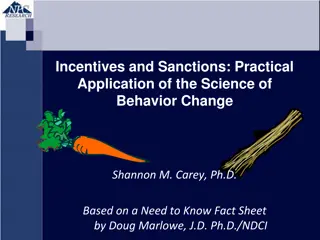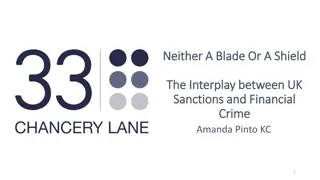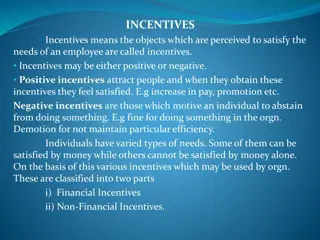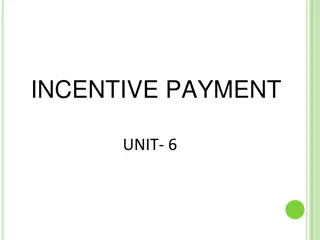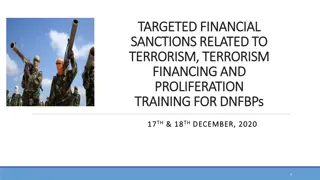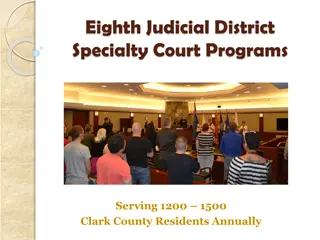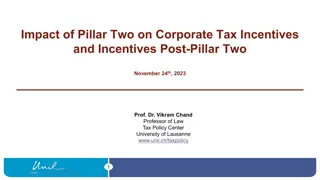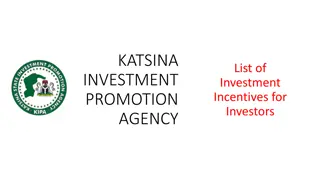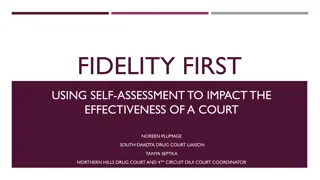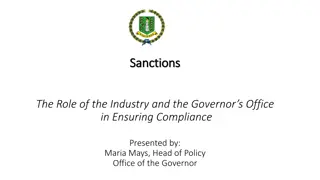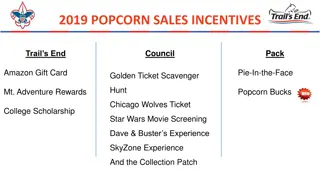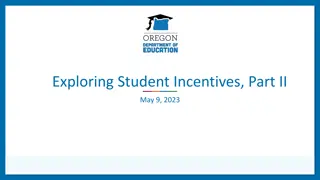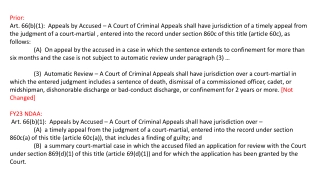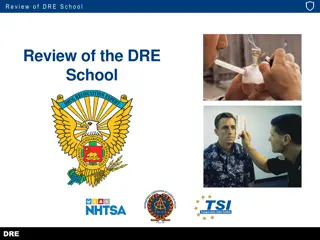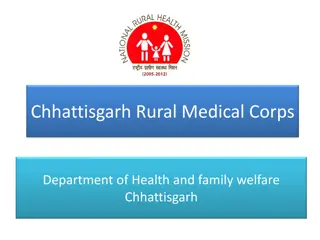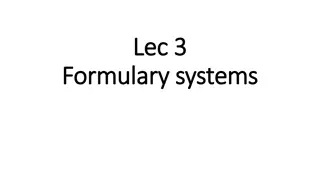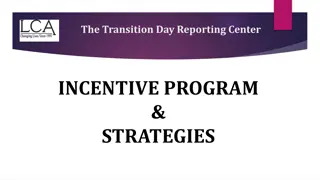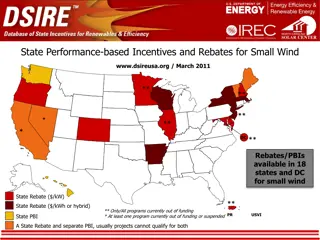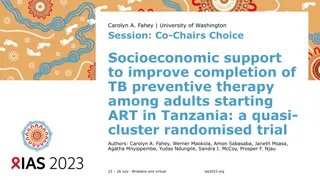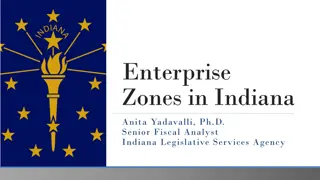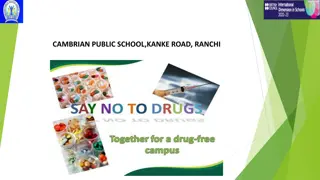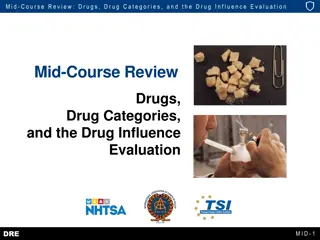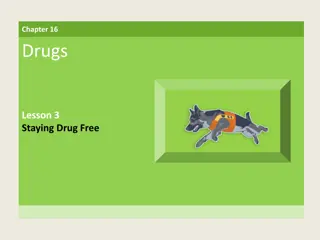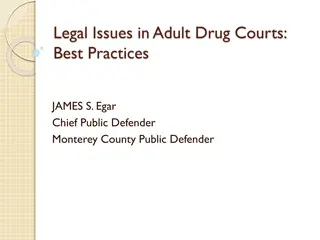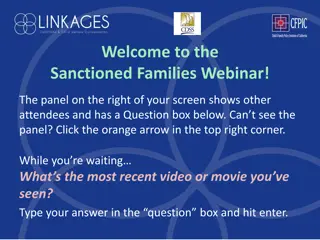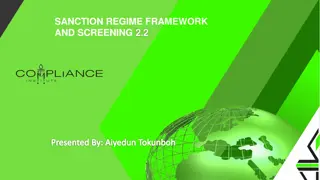Practical Guide to Incentives and Sanctions in Drug Court Training
Comprehensive guide developed by Douglas B. Marlowe, J.D., Ph.D., and presented by Carolyn Hardin from the National Drug Court Institute, covering basic terminology, carrot and stick approach, goal-setting strategies, treating substance dependence, delivering sanctions, building trust, importance of timing, procedural fairness, and optimizing the effectiveness of interventions in drug court training.
Download Presentation

Please find below an Image/Link to download the presentation.
The content on the website is provided AS IS for your information and personal use only. It may not be sold, licensed, or shared on other websites without obtaining consent from the author. Download presentation by click this link. If you encounter any issues during the download, it is possible that the publisher has removed the file from their server.
E N D
Presentation Transcript
National Drug Court Institute Drug Court Training Practical Guide to Incentives and Sanctions Developed by: Douglas B. Marlowe, J.D., Ph.D. Presented by: Carolyn Hardin, Senior Director NDCI: A Professional Services Division of NADCP
Basic Terminology SANCTION REWARD Punishment Positive Reinforcement GIVE Negative Reinforcement Response Cost TAKE NCDC: A Professional Services Division of NADCP
Carrot and Stick Reduce undesirable behaviors and increase desirable behaviors Positive vs. negative reinforcement NDCI: A Professional Services Division of NADCP
First Things First Proximal Goals Distal Goals NDCI: A Professional Services Division of NADCP
Treat or Punish Substance Dependence or Addiction 1. Triggered binge pattern 2. Cravings or compulsions 3. Withdrawal symptoms Abstinence is distal goal Substance Abuse Abstinence is a proximal goal Collateral needs Dual diagnosis Chronic medical condition (e.g., HIV+, HCV, diabetes) Homelessness, chronic unemployment Regimented compliance is proximal NDCI: A Professional Services Division of NADCP
Sanctions or Therapeutic Consequences Treatment responses should be delivered by treatment professionals NDCI: A Professional Services Division of NADCP
Trust But Verify Certainty Reliably Detection NDCI: A Professional Services Division of NADCP
Timing Is Everything Responses should be delivered immediately NDCI: A Professional Services Division of NADCP
Do Due Process Procedural fairness Clear expectation explanation Method of delivery Respect and dignity NDCI: A Professional Services Division of NADCP
Staying Centered: Magnitude Effective Zone Ceiling Habituation Effects EFFECTIVENESS Effects LOW MODERATE High MAGNITUDE OF SANCTION
Fishing for Tangible Resources NDCI: A Professional Services Division of NADCP
Target Behaviors Don t expect too much Learned helplessness and ratio burden Don t expect too little Habituation Proximal vs. distal goals Phase specificity NDCI: A Professional Services Division of NADCP
Tangible Rewards Most important for reinforcement- starved participants Point systems Symbolic rewards NDCI: A Professional Services Division of NADCP
Examples of I/S www.NDCRC.org NDCI: A Professional Services Division of NADCP
Low Magnitude Rewards Verbal praise For all routine behaviors From all team members Small tangible rewards For adherence to routine (e.g., full week attendance) Pro-social (e.g., day planners, calendars, alarm clocks, bus tokens, bookmarks, phone cards, healthy snacks, toiletries, clean underwear, coffee mugs) Pro-sobriety (e.g., serenity stones, Live Strong bracelets, T- shirts with inspirational messages, coffee mugs with logo, refrigerator magnets with crisis numbers) NDCI: A Professional Services Division of NADCP
Low Magnitude Rewards Recognition in court Early milestone (e.g., 30 days abstinence) Round of applause, handshake from judge, and/or certificate Symbolic rewards Clinically significant milestone (e.g., 90 days abstinence; completion of basic treatment curriculum) Sobriety chips, tokens or key chains; paperback edition of Big Book or comparable literature Posted accomplishments Individualized achievements E.g., posted artwork, essays, poems, diplomas, graduation pictures NDCI: A Professional Services Division of NADCP
Low Magnitude Rewards Written commendations To whom it may concern Letter of attainment from judge; or report card from case manager or probation officer NDCI: A Professional Services Division of NADCP
Moderate Magnitude Rewards Reduced supervision Avoid over-reliance for high-need participants Not treatment conditions! Reduced community restrictions E.g., extended curfew or relaxed area restrictions Enhanced milieu status On-site peer mentors; or lead group discussions Moderate tangible rewards (fishbowl) Initiate productive or healthful activities Introductory spa or gym membership, cosmetic session, movie passes, haircuts, bowling or skating passes
Moderate Magnitude Rewards Self-Improvement services Life preparation for those getting ready to move on Resume writing; dress for success; prevocational classes; GED; meal preparation Supervised social gatherings Supervised by program staff Picnics, sober dances, recovery games, family day, picture day
High Magnitude Rewards Supervised day trips Off-site Movie outings, bowling trips, sporting events Travel privileges Begin with phone-in conditions Substantial tangible rewards Commemorative Big Book ; sports or concert tickets; spa memberships; yoga or Tai Chi classes; celebrity autographs; donated educational scholarships Point Systems NDCI: A Professional Services Division of NADCP
High Magnitude Rewards Ambassadorships Preparatory classes How to tell your story Commencement Robes, Pomp & Circumstance, pictures with the judge and arresting officer, celebrity speeches, framed diplomas, media coverage Legal incentives Dismissal of charges; reduced sentence; consolidation of probationary terms; record expungement NDCI: A Professional Services Division of NADCP
Low Magnitude Sanctions Verbal admonishments By all staff at time of infractions Never disrespectful or insulting Clarify: (1) nature of infraction, (2) importance of compliance, (3) future sanctions, and (4) alternative actions Letters of apology or explanation May or may not read it aloud Tape recordings in lieu of writings Essay assignments Easily digestible library of recovery topics Daily activity scheduling and logs NDCI: A Professional Services Division of NADCP
Low Magnitude Sanctions Journaling Thoughts, feelings, expectations Tape recordings in lieu of writings Life skills assignments Learn how and prepare to: open a bank account, take public transportation, enroll in school, find a job, obtain ID Jury Box observation Drug Court or other proceedings NDCI: A Professional Services Division of NADCP
Low Magnitude Sanctions Increased community restrictions Team round-tables Feedback from multiple viewpoints Plug gaps in communication and contain splitting NDCI: A Professional Services Division of NADCP
Moderate Magnitude Sanctions Increased supervision Not treatment! Phase demotion Prepare for more effective transition Useful community service Monetary fees ( fines) Realistic ability to pay Holding cell at courthouse Warning tours NDCI: A Professional Services Division of NADCP
High Magnitude Sanction Day reporting center Electronic surveillance Monitored home detention Flash incarceration Effectiveness and cost-effectiveness decline rapidly after 3 to 6 days Opportunity to prepare Termination NDCI: A Professional Services Division of NADCP
Readings Burdon WM et al (2001). Drug courts and contingency management. Journal of Drug Issues, 31, 73-90. Harrell A & Roman J (2001). Reducing drug use and crime among offenders: The impact of graduated sanctions. Journal of Drug Issues, 31, 207-232. Marlowe DB (2007). Strategies for administering rewards and sanctions. In JE Lessenger & GF Roper (Eds.), Drug courts: A new approach to treatment and rehabilitation (pp. 317-336). New York: Springer. Marlowe DB (2008). Application of sanctions. In Drug Court Quality Improvement Monograph. Alexandria, VA: NDCI. Marlowe DB & Wong CJ (2008). Contingency management in adult criminal drug courts (pp. 334-354). In ST Higgins, K Silverman & SH Heil (Eds.), Contingency management in substance abuse treatment. New York: Guilford. Marlowe DB (2011). Applying incentives and sanctions. In The drug court judicial benchbook (pp.139-157). Alexandria, VA: NDCI. NDCI: A Professional Services Division of NADCP
SPONSORS NOTE This project was supported by Grant No. 2010-DC-BX- K091 awarded by the Bureau of Justice Assistance. The Bureau of Justice Assistance is a component of the Office of Justice Programs, which also includes the Bureau of Justice Statistics, the National Institute of Justice, the Office of Juvenile Justice and Delinquency Prevention, the SMART Office, and the Office for Victims of Crime. Points of view or opinions in this document are those of the author and do not represent the official position or policies of the United States Department of Justice. NDCI: A Professional Services Division of NADCP


